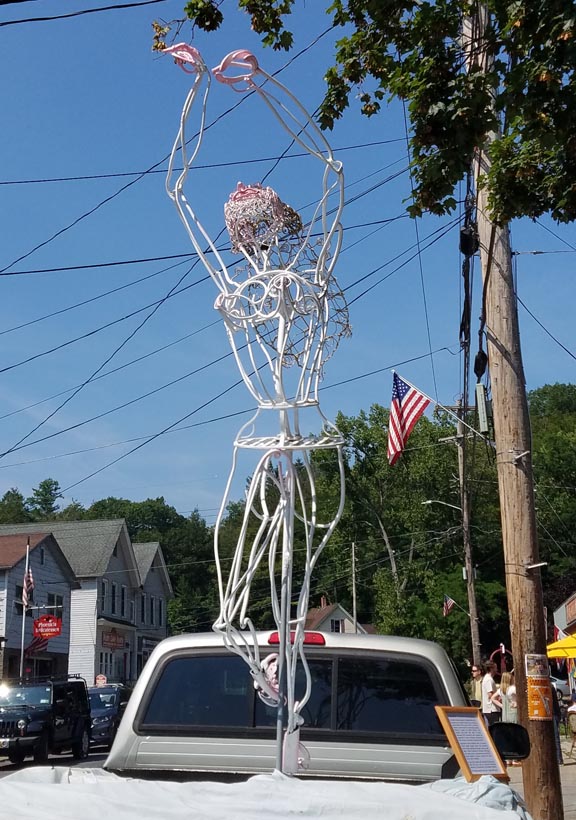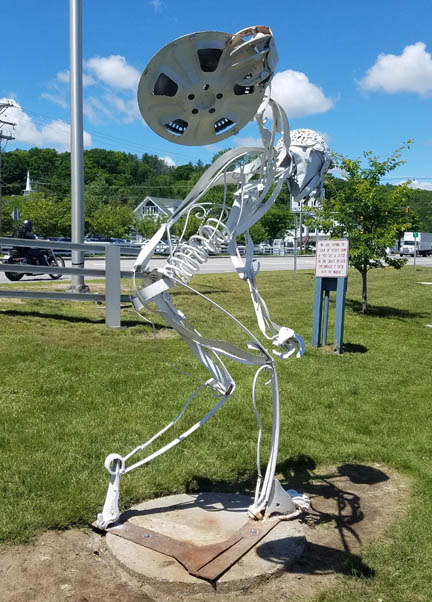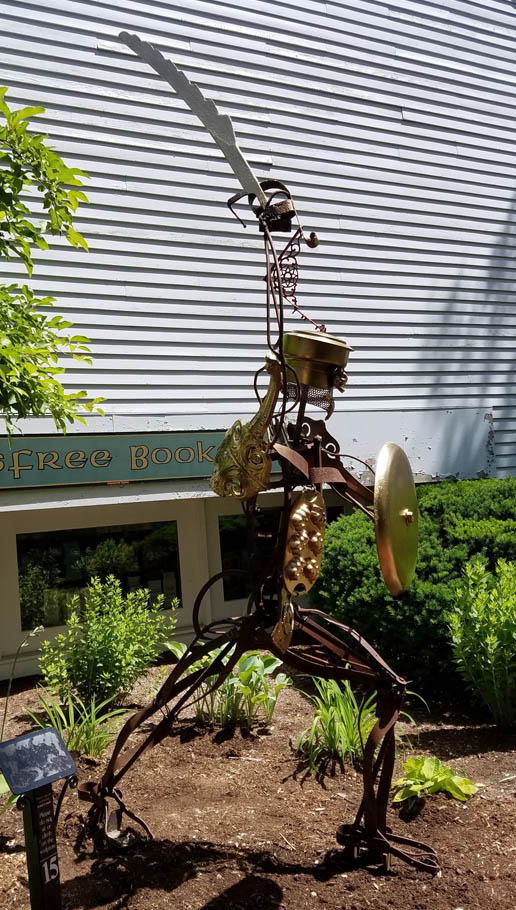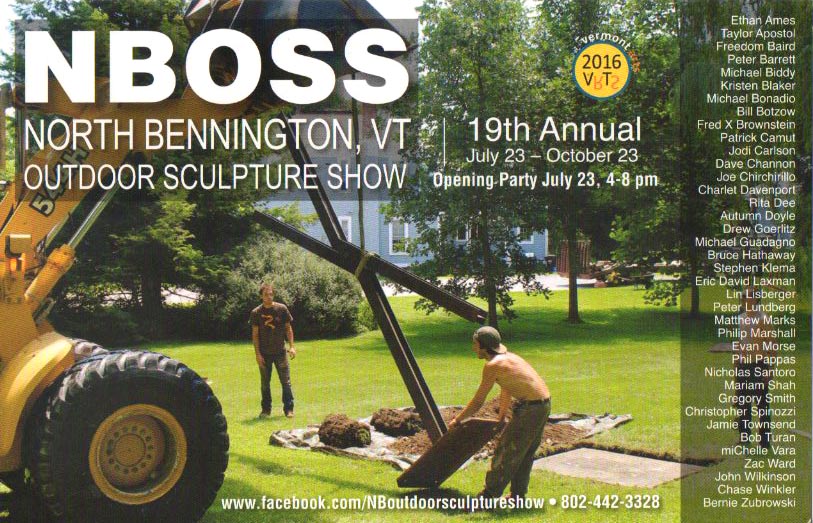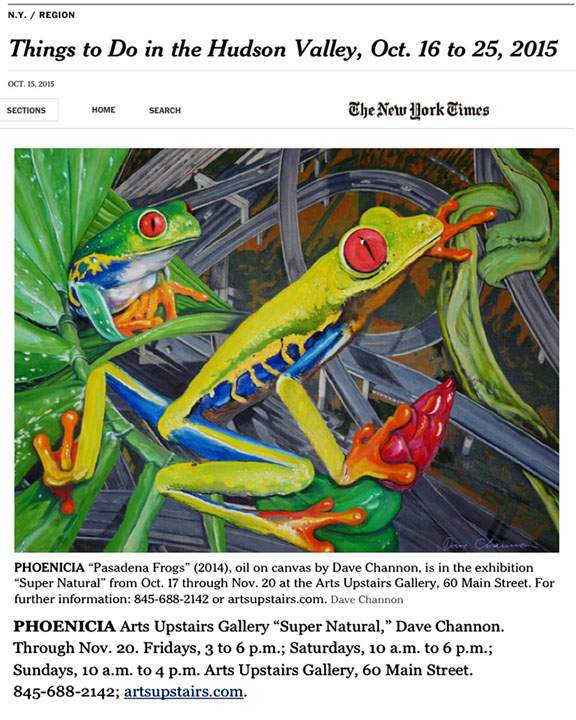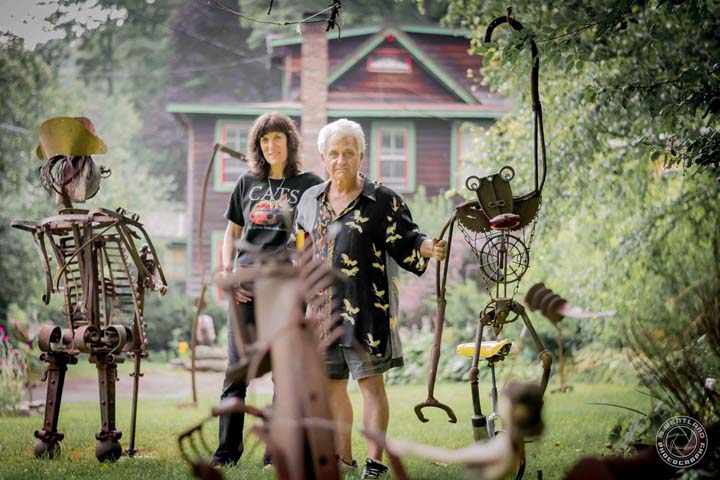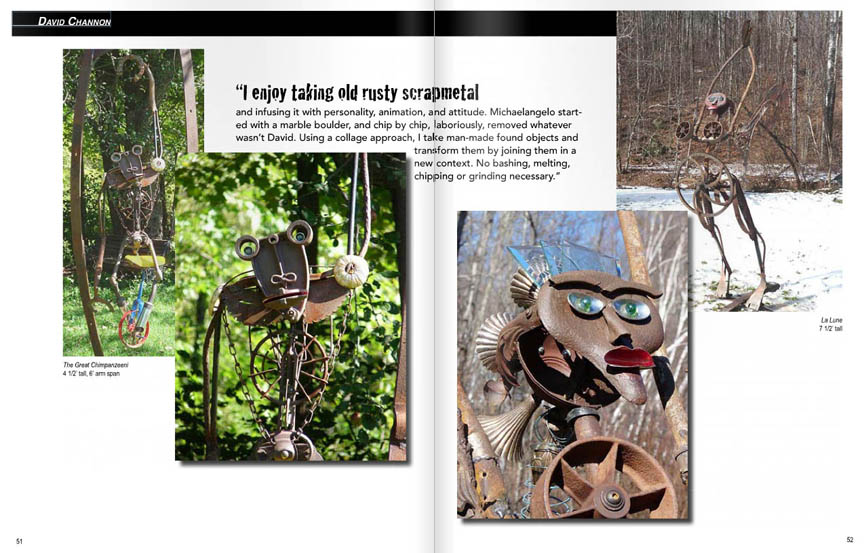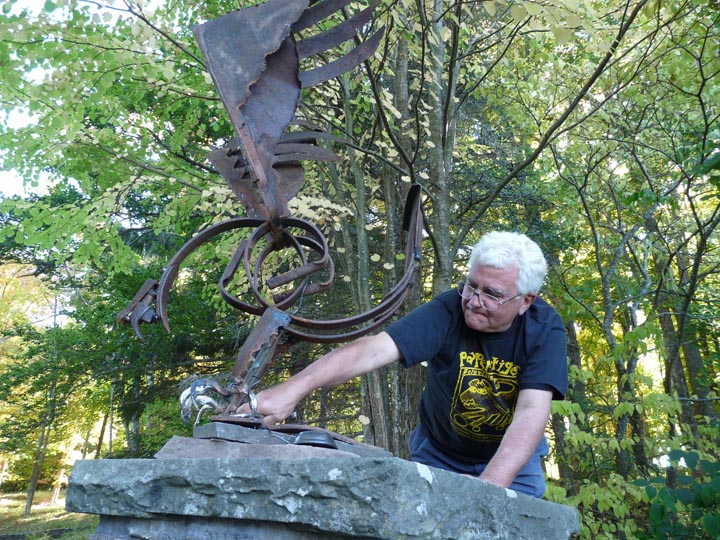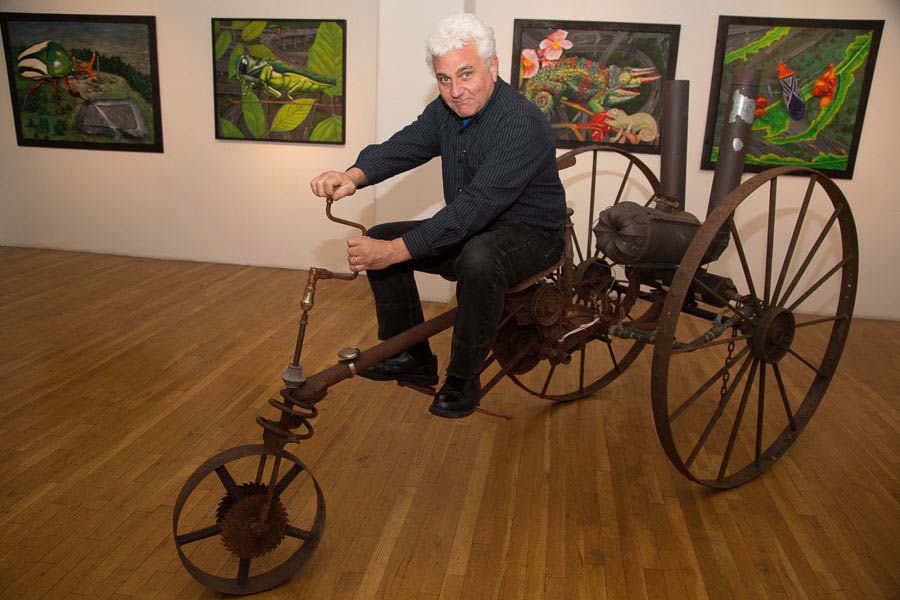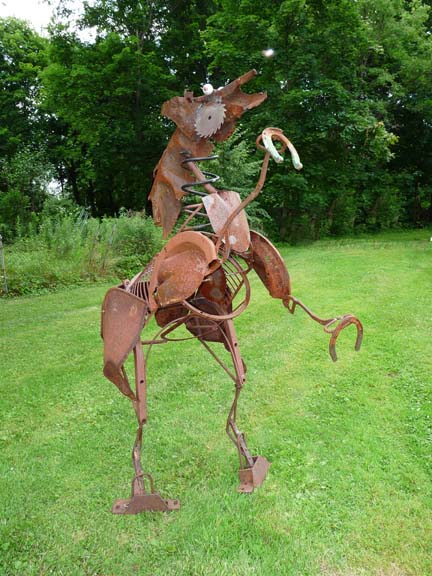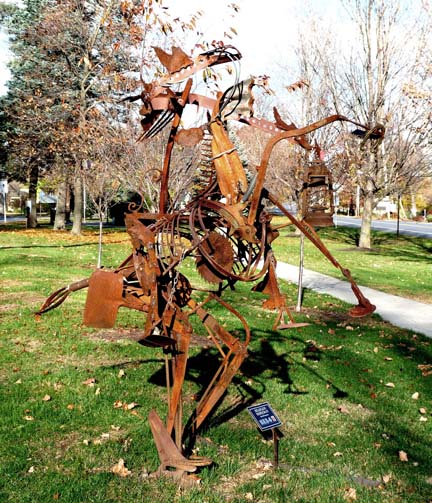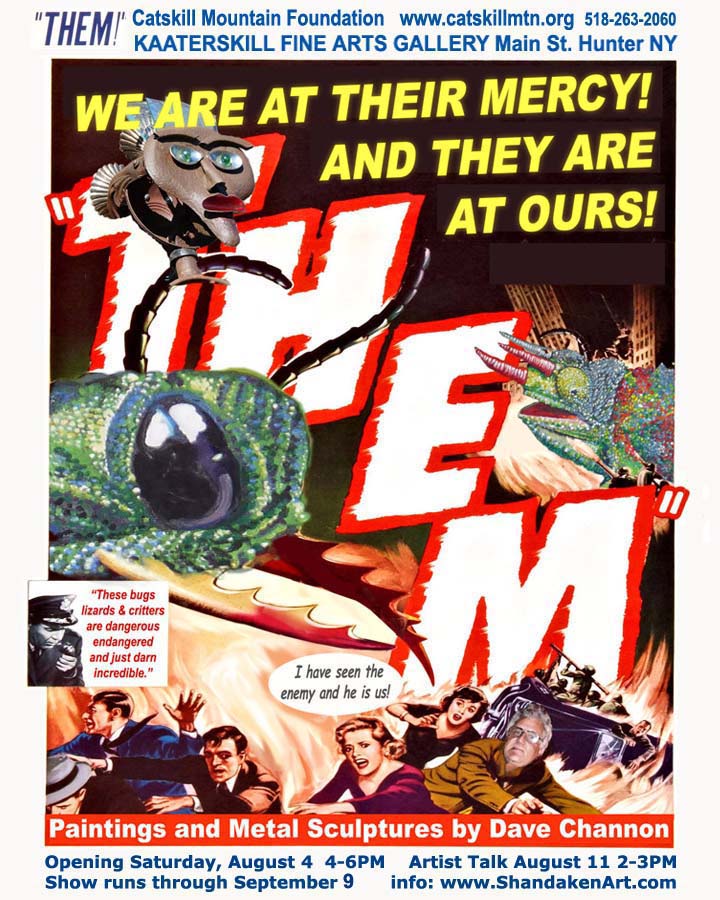The Studio of Dave Channon Recent Exhibitions
Exhibitions Welded Steel Paintings Digital Art Illustration Video Animation Web Design Contact Home
See the Owl at Shandaken Inn
GALATEA World premiere in Phoenicia Festival of the Arts at Wellness Rx
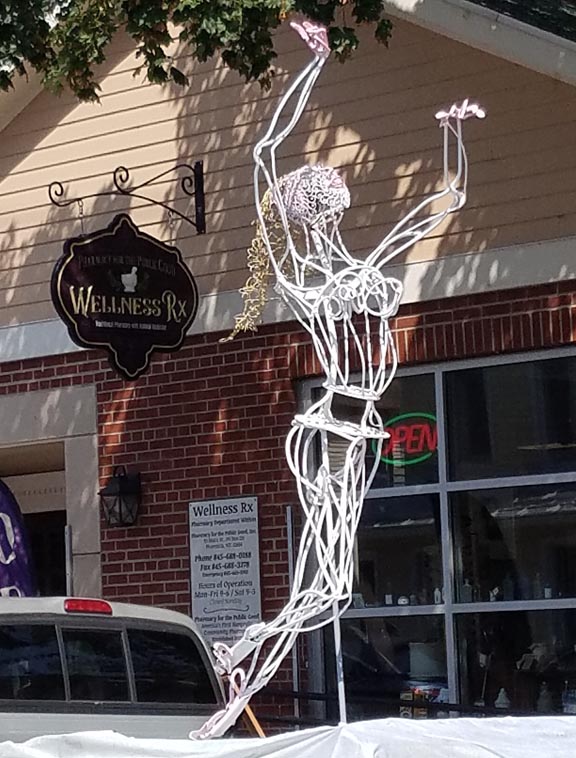
 GALATEA Is a scrapture by Dave Channon. In Ovid’s Metamorphosis, PYGMALION was a sculptor who created a statue of a woman so perfect that he fell in love with it, called it Galatea and dressed it in sensuous clothes. (Today it might be called Barbie.) But Galatea was hard and cold as stone. Obsessed and tormented with passion, he appealed to Venus to change Galatea into a real woman. Venus had sympathy and did. Pygmalion named Galatea after an ancient Greek forest nymph Naiad who presided over brooks, springs, fountains, swamps and bogs. Think freshwater Mermaid with legs and super powers. Cyclops loved her but she loved another. Cyclops crushed her other lover with a boulder.
GALATEA Is a scrapture by Dave Channon. In Ovid’s Metamorphosis, PYGMALION was a sculptor who created a statue of a woman so perfect that he fell in love with it, called it Galatea and dressed it in sensuous clothes. (Today it might be called Barbie.) But Galatea was hard and cold as stone. Obsessed and tormented with passion, he appealed to Venus to change Galatea into a real woman. Venus had sympathy and did. Pygmalion named Galatea after an ancient Greek forest nymph Naiad who presided over brooks, springs, fountains, swamps and bogs. Think freshwater Mermaid with legs and super powers. Cyclops loved her but she loved another. Cyclops crushed her other lover with a boulder.
If you love Galatea let me know! If you must have her, you can for $10,000 including delivery & installation. No Cyclops boulders. Dave@EsopusCreek.com (845) 688-2977
"ARTemis" Unveiled at Bennington Vermont Art Museum
The Greek Goddess: Daughter of Zeus, hunter, wrathful virgin, midwife, twin sister of Apollo
Leaping with her faithful dog.
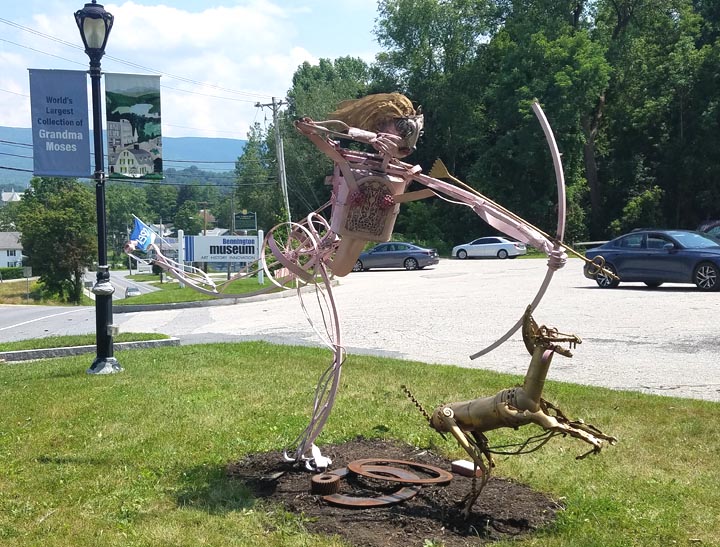
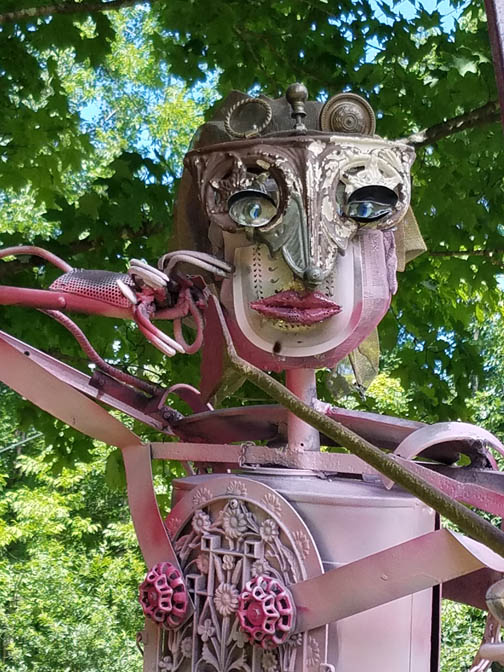
"Discus Hurler" was at Lake Winnepesaukee in Meredith New Hampshire.
On display now at Mt. Tremper Train Station next to Emerson Resort on Rt 28.
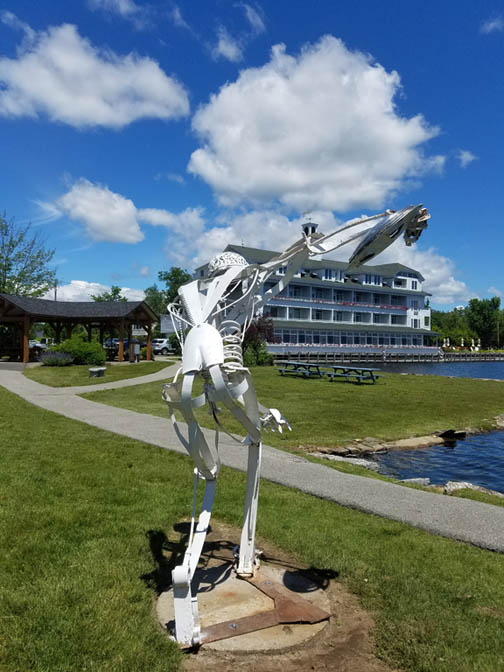
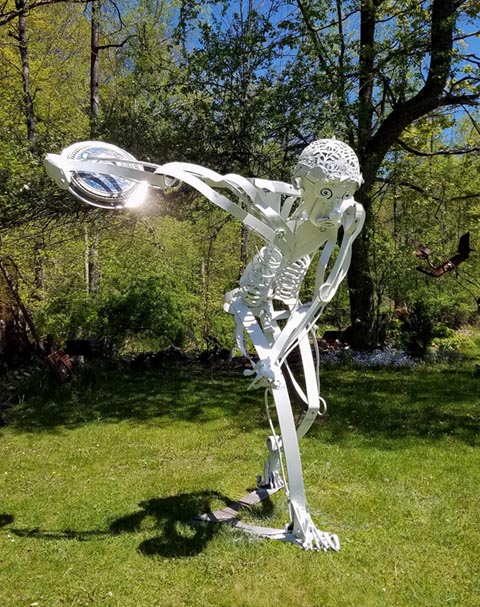
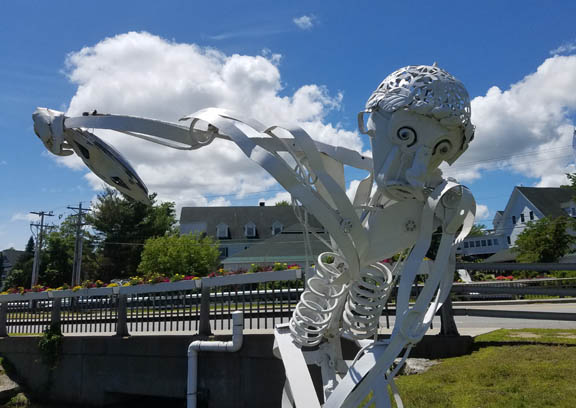
Warrior is nestled in the village shops
Discus Hurler Is $10,000 Warrior is $6,000 ARTemis i $10,000 CLICK HERE
Scraptures by Dave Channon at Woodstock Art Exchange 1396 Rt. 28
Watch the virtual walking tour video of 17 Scraptures. Reserve your tour now! CLICK HERE
"Golfzilla" and "Esopus Creek Monster" Featured in new HBO Movie "Pretty Little Liars"! Look for it!
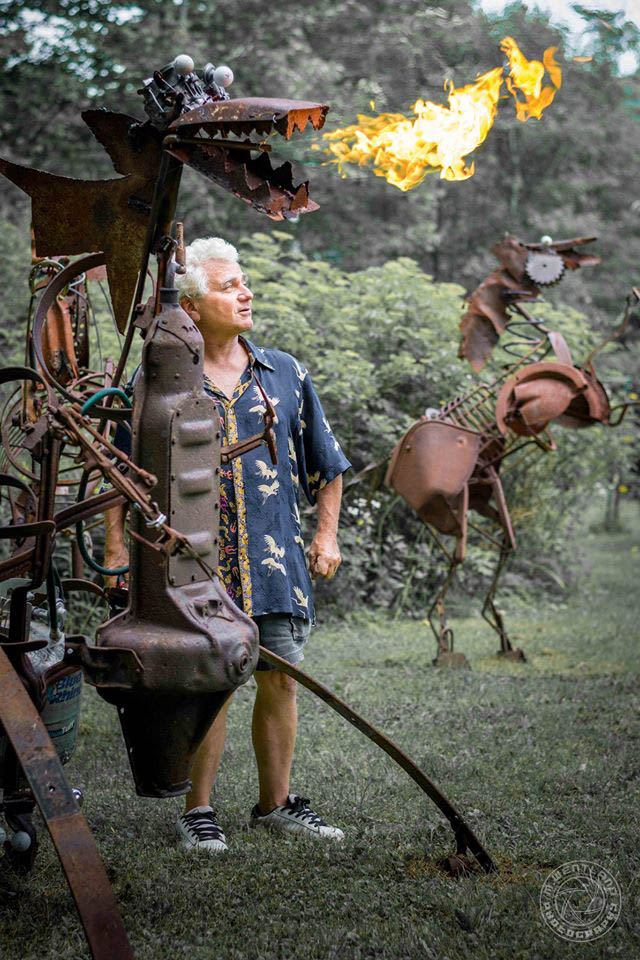
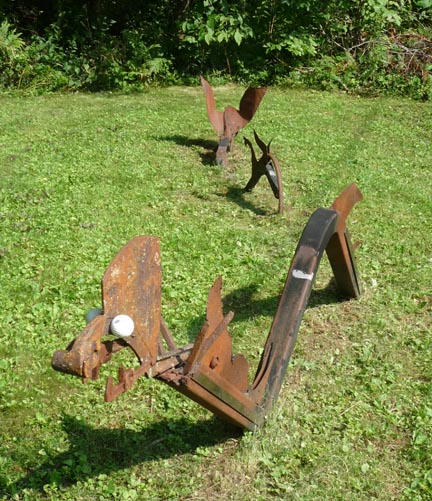
“Scrapsody in Green” - The World Premiere of “Big Mermaid” 12/4 & 5
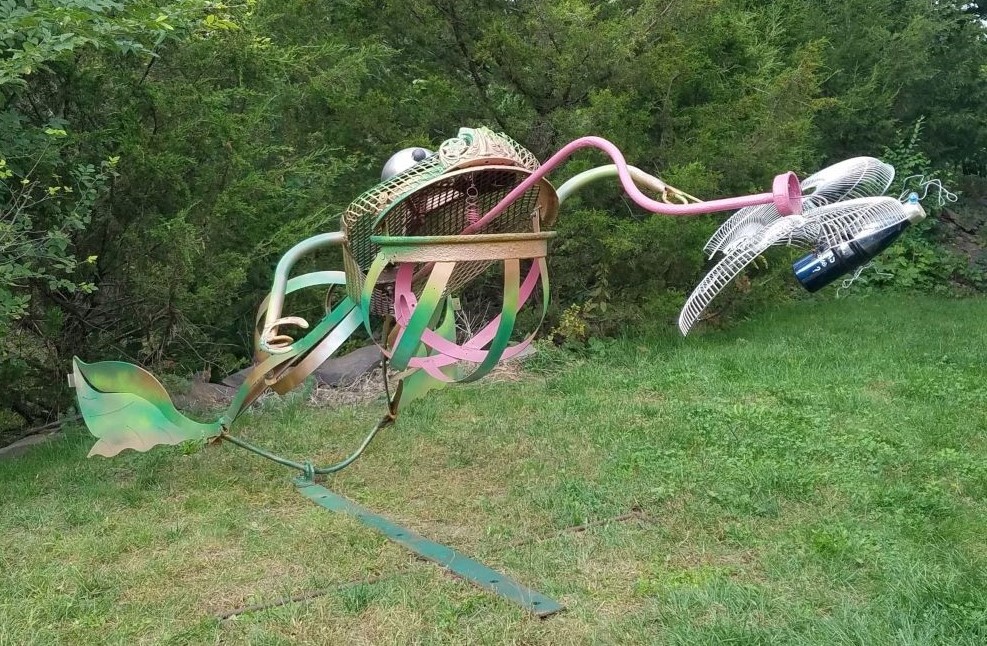
“Mr. Toad” welomes you to Woodstock Art Exchange for the World Premiere of "Big Mermaid" 12/4 & 5
“Scrapsody in Green” - The World Premiere of “Big Mermaid”, "Mr. Toad" and many more Scraptures by Dave Channon. At The Woodstock Art Exchange 1396 Route 28 on Saturday and Sunday, December 4th and 5th, from 1-5PM, with a free revolving guided tour by the artist. One lucky visitor will win a Channon scrapture. An array of giftable art will also be on display in the WAE Gallery annual holiday show. “Scrapsody in Green” is an outdoor exhibition 24/7 365 so you can visit any day, anytime. Contact Dave Channon to meet you in person for a guided tour. Dave@EsopusCreek.com or phone (845) 688-2977.
“Scrapsody in Green”
What does “green” mean? Verdant, juvenile, pullulating, pubescent, unripe… Or recycled, sustainable, solar, and wind? All of the above!
Emerald, spring, grass. The human eye is far more sensitive to green than any other color. We used to live surrounded by green and the lucky among us still do. The ability to distinguish between infinite shades of green was once necessary to our ancestors’ survival in a green jungle. Today “going green” is crucial to our survival as a species. And the survival of every other species on the planet.
The Woodstock Art Exchange will celebrate the verdancy of greenness on December4th and 5th with the world premiere of Dave Channon’s scraptures, “Big Mermaid”, “Mr. Toad”, and “Ms. Liberty”, with a revolving guided tour by the artist, amidst a holiday cornucopia of fine giftable art of every color (including green).
Dave Channon’s scraptures of recycled steel have a Frankensteinian tint: bolted and welded from spare parts like the grey-green monster. The 10 foot “Mr. Toad” is chartreuse bronze, jumping, wobbling, belly gobbling, tongue darting, to snatch a fly from thin air. Following close on the tail of Dave Channon’s wriggling tadpole imagination, we have the “Big Mermaid”. She leaps trout-like from the green grass ocean to embrace the sky, jade scales shining, her torqued torso in extremis like the pain suffered by Hans Christian Andersen’s Little Mermaid while transitioning into a two legged beauty. (Little known factoid: unlike the Disney version, the original Little Mermaid gained her immortal soul in the form of a cooling breeze that cured the plague. If only Channon’s Big Mermaid could do the same!) Channon’s “Ms. Liberty” wears a new turquoise-copper patina, while balancing a lopsided scale of justice in her arms. Verdigris! You may wonder how the energy intensive art of welding steel can be truly green? Channon’s arc welder is powered by renewable wind, solar and non-fossil fueled electricity!
The Woodstock Art Exchange Gallery annual holiday sale features glass master Pablo Weinschenk, a host of glass artists, and many treasures in other media. And Dave Channon’s new scraptures will look great on the green green grass of your home. At The Woodstock Art Exchange on Saturday and Sunday, December 4th and 5th, from 1-5 PM, with a revolving guided tour by the artist. One lucky visitor will win an adorable “Porcupine” scrapture! Don’t go green with envy – Come to the premiere and you might get as lucky as a green four leaf clover.
Woodstock Art Exchange 1396 State Route 28- Contact: (646) 256-9688 or (845) 688-2977 Email: Georganne@WoodstockArtExchange.com or Dave@EsopusCreek.com and visit www.WoodstockArtExchange.com or www.EsopusCreek.com
"Detroitus the Discus Hurler" was a hit at Phoenicia festival of the Voice 2021
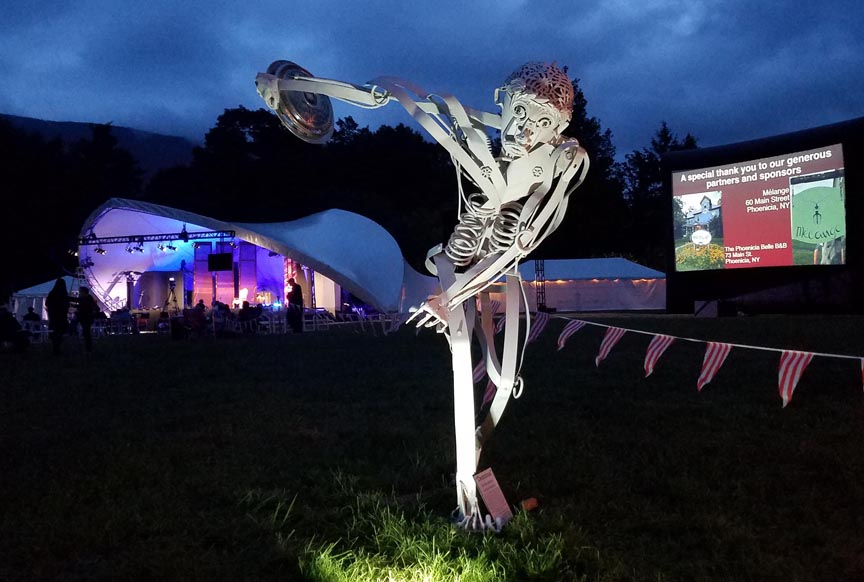
Flash! Dave Channon's CoCo the Gorilla is in USA Today! Visit SculptureForLeonia.org Look at the Artist Index!
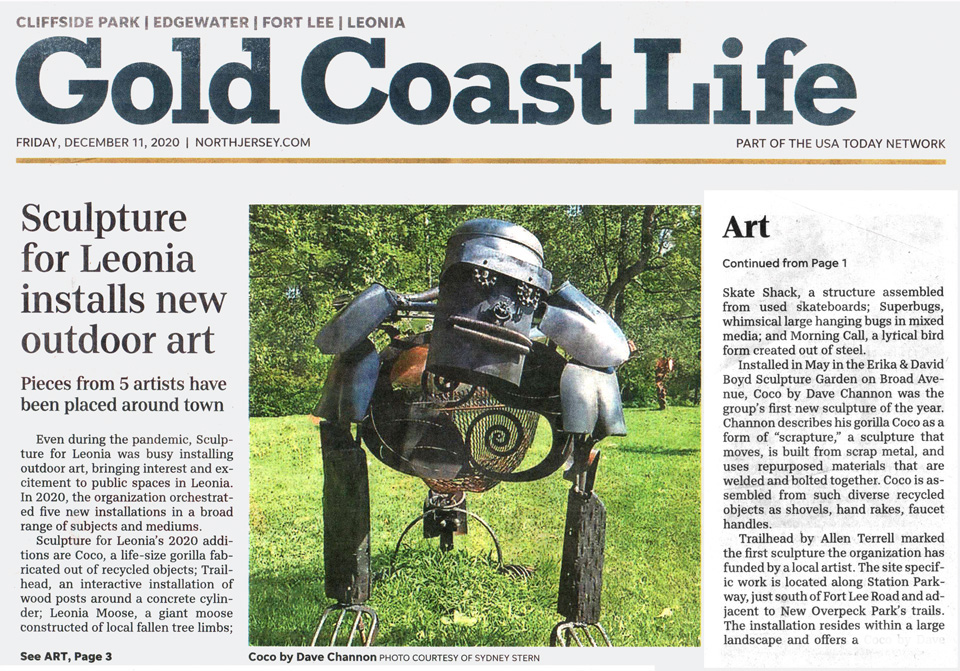
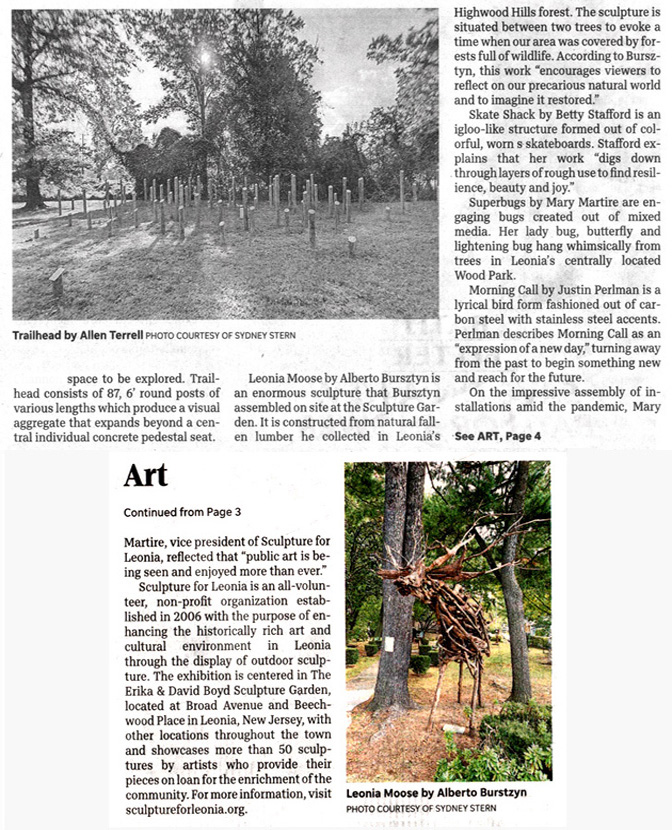
Scraptures by Dave Channon at Woodstock Art Exchange 1396 Rt. 28
West Point Highland Falls ArtWalk put my "Sweet Chariot" on the catalog cover!
New York Times: "Living in Highland Falls" 7/26/2018

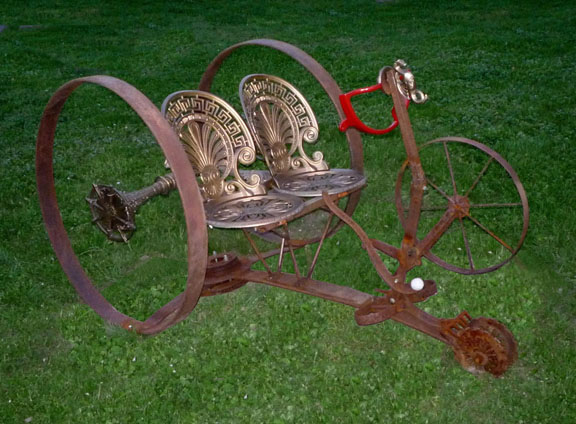
"Atargatis" the Phoenician Mermaid at the Catskill Interpretive Center
(Maurice Hinchey Gravesite in background) 2018
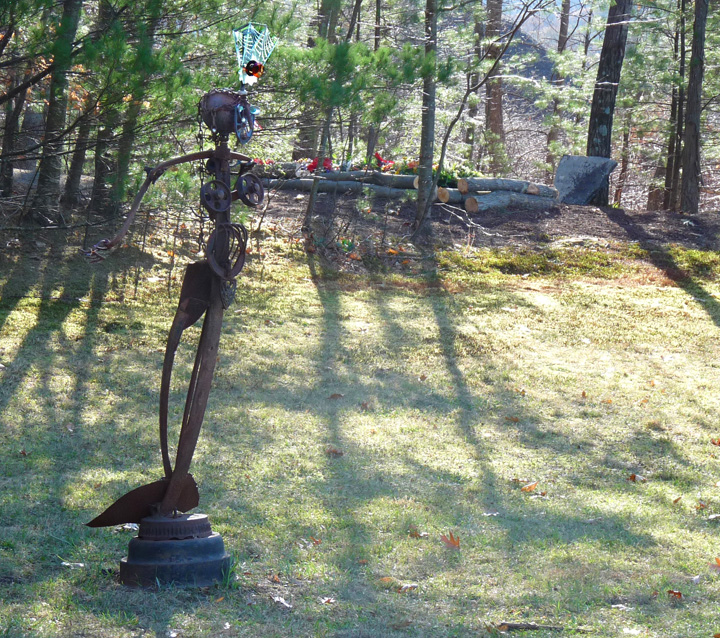
| "Statue
of Liberty and Justice for Earth" at the Catskill
Interpretive Center in Mt. Tremper
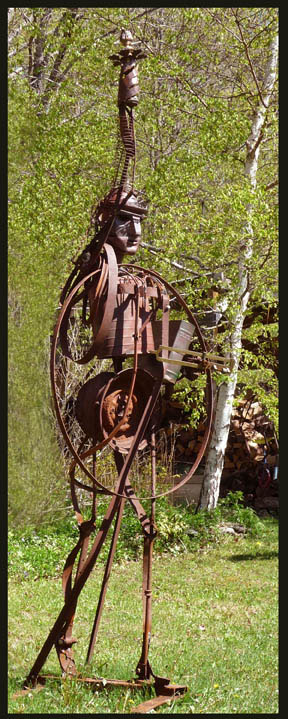 |

|
"Lightningbolt"
at N. Bennington Vt.
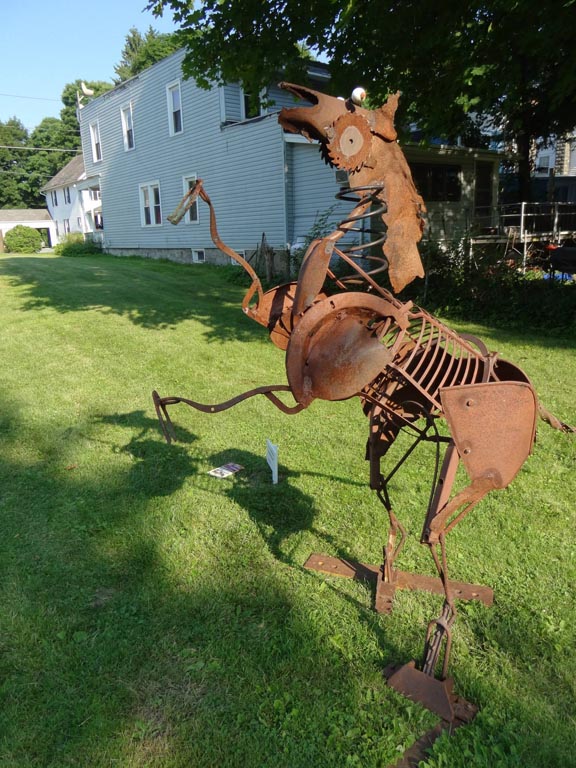 |
| Governor's
Island Go Figure show "Napoleon"
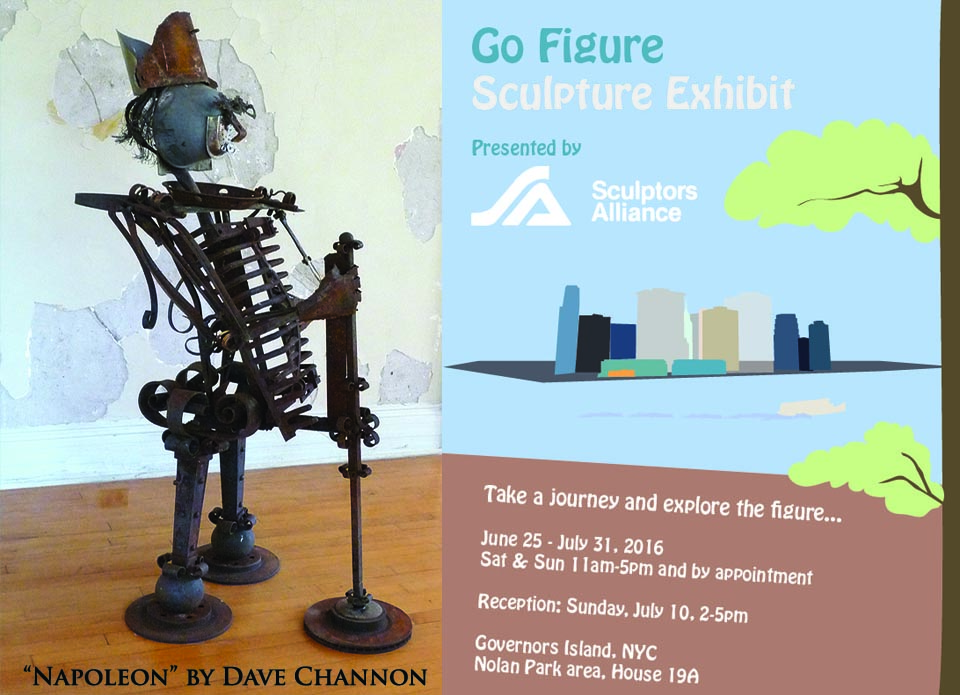 |
North Bennington NBOSS show "Steampunk Trike" Read review of NBOSS 2016 show in North Bennington Vt.
|
"SUPER NATURAL" SOLO RETROSPECTIVE @ THE ARTS UPSTAIRS
60 MAIN ST. PHOENICIA - OPENING SATURDAY OCT. 17 6-9 PM - RUNS THOUGH NOV 20
Kingston Daily Freeman Article Woodstock Times Article
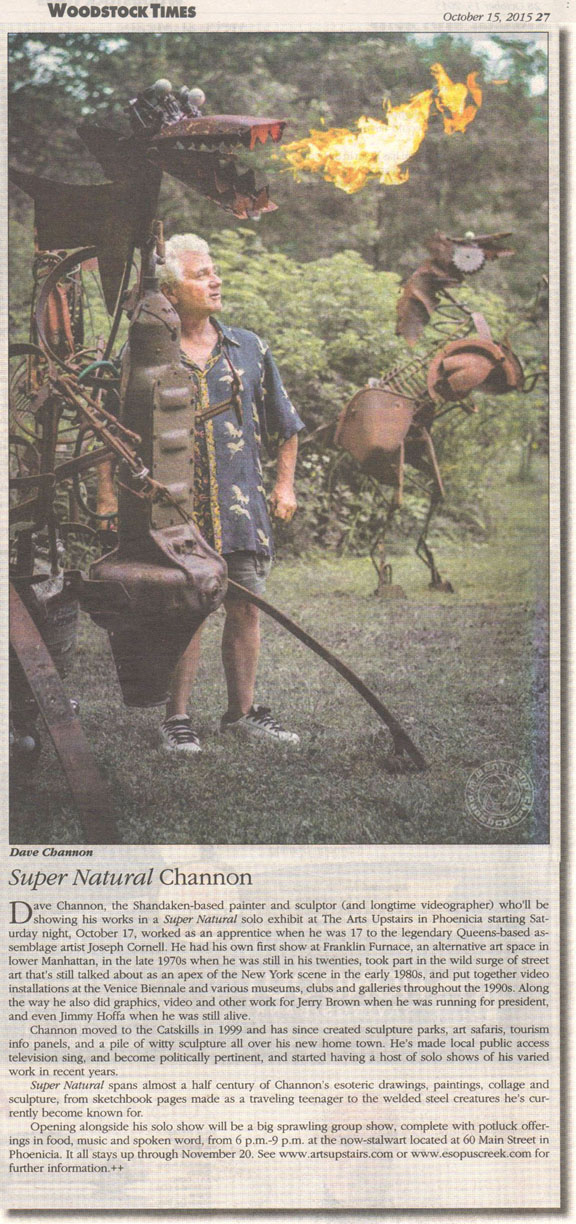
Woven Tale Press feature article on Dave Channon Oct 1, 2015
CIC Mt. Tremper NY - NBOSS2015 North Bennington VT - RHCAN2015 Red Hook NY - Saunders Farm, Garrison NY
| Dave Installing one of a pair of "Eagles" 49A at Art Park at the Galli-Curci Mansion in Highmount
|
|
|
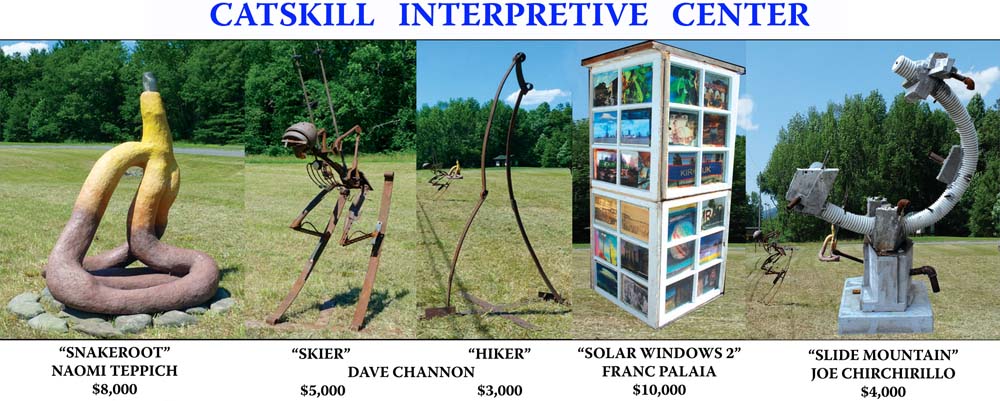
Dave Channon on his "Steam Punk Dragster" at Omens of Climate Change show Feb 1 - 16, 2014 - Westbeth Gallery in Manhattan |
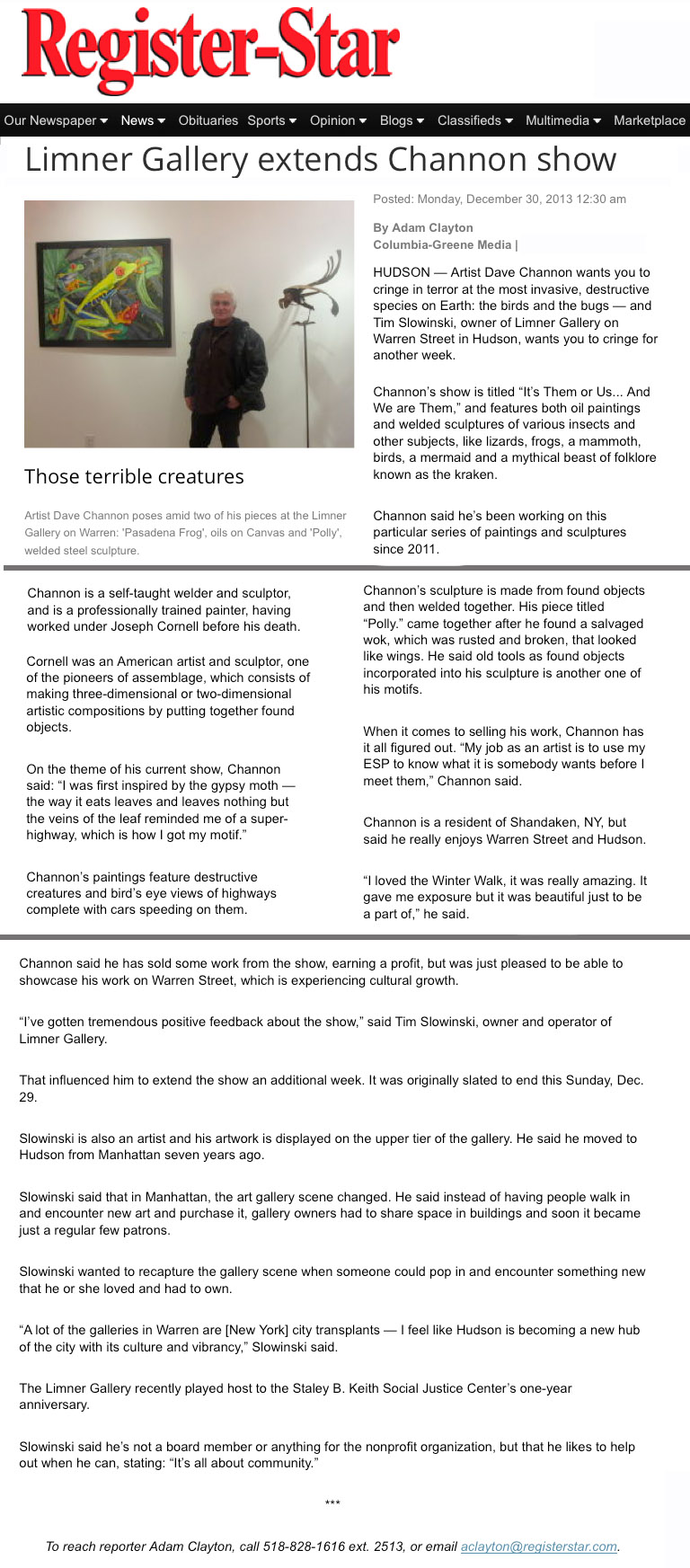
"An interesting Artist" interview by Alex Meisler CLICK HERE to download
View us on ARTSLANT Dave Channon: Rennaisannce man!
Scenes From Recent Exhibitions:
|
|
"Thunderhoof" N Bennington
|
"Headless Horseman" Red Hook, NY
|
|
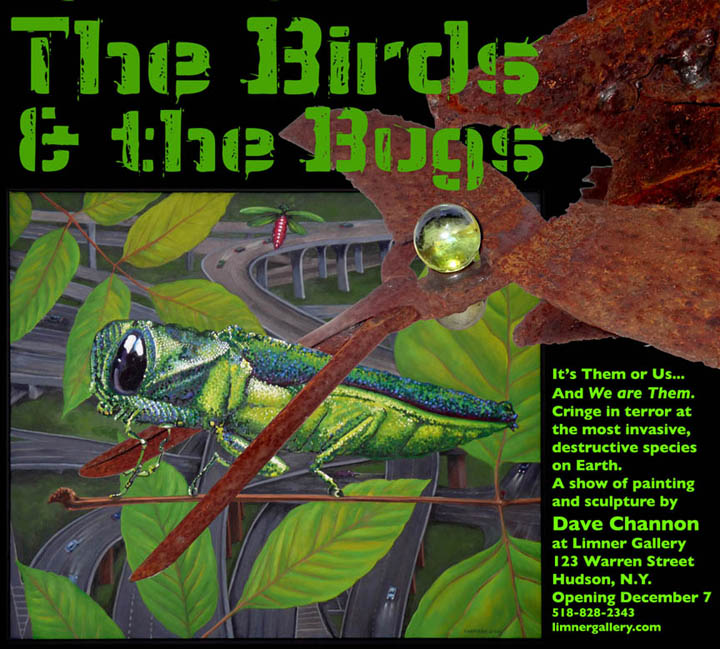
Shandaken Art Studio Tour 2014 "Tree Hugger" at 49A Art Park in Highmount
"OMENS OF CLIMATE CHANGE" at Westbeth gallery Feb 1 - 16, 2014 Read review on SciArtInAmerica.com
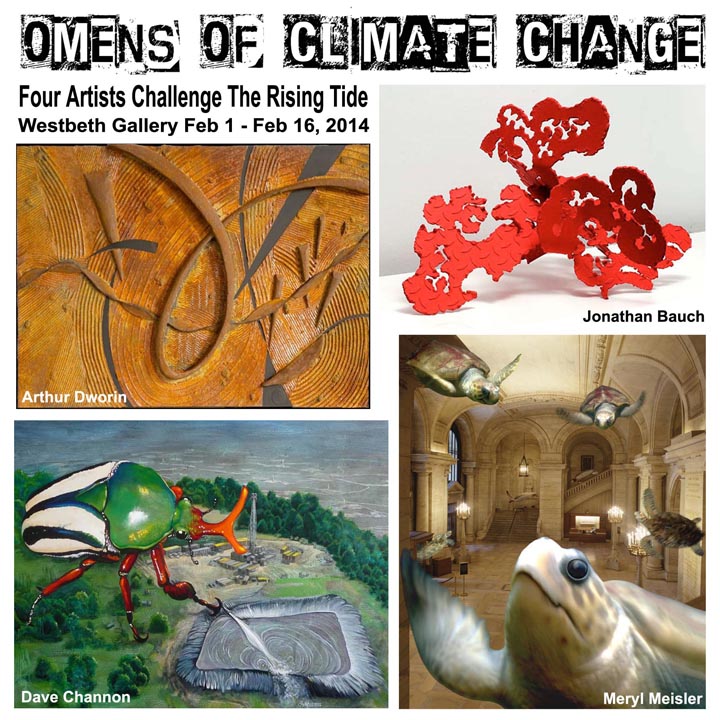
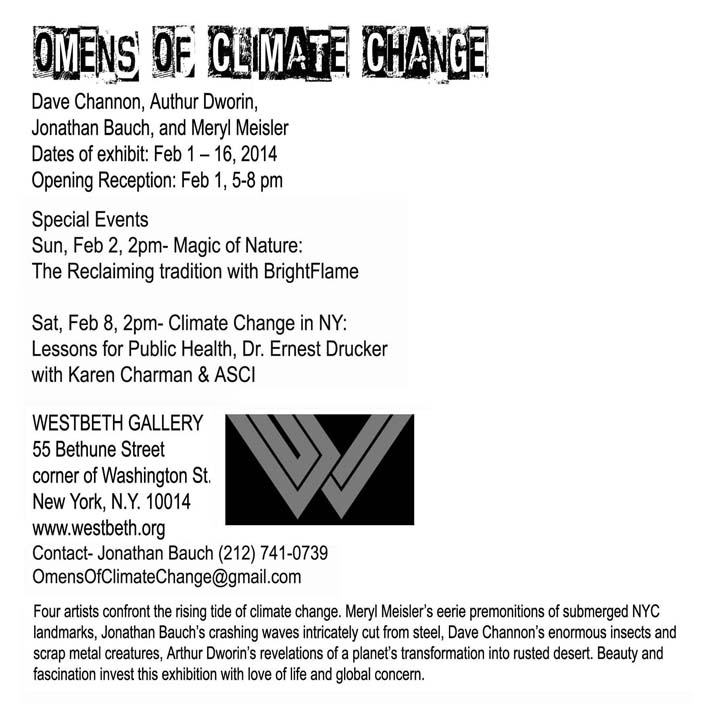
Scenes from Omens of Climate Change
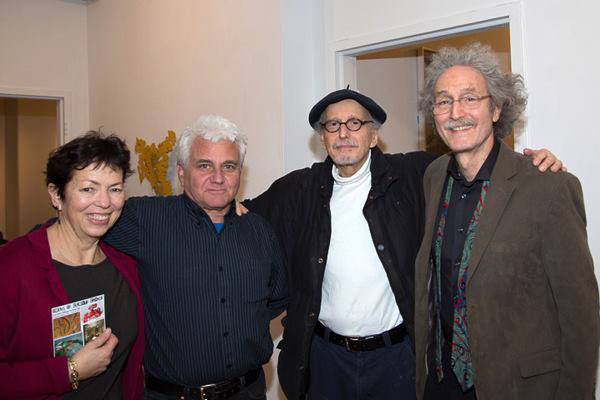
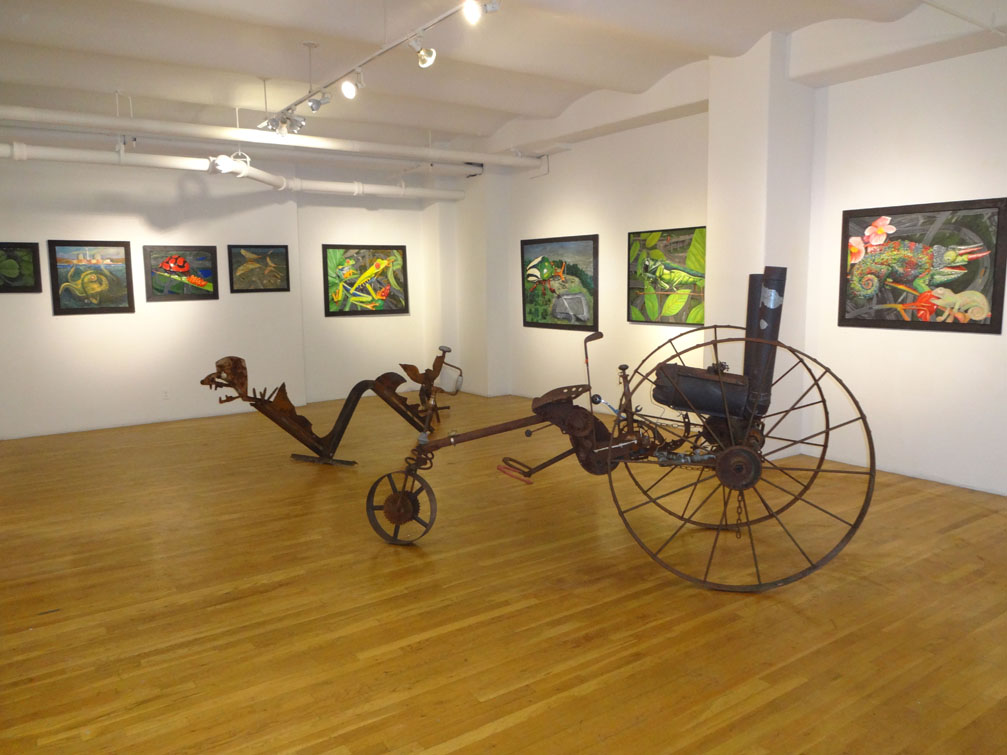
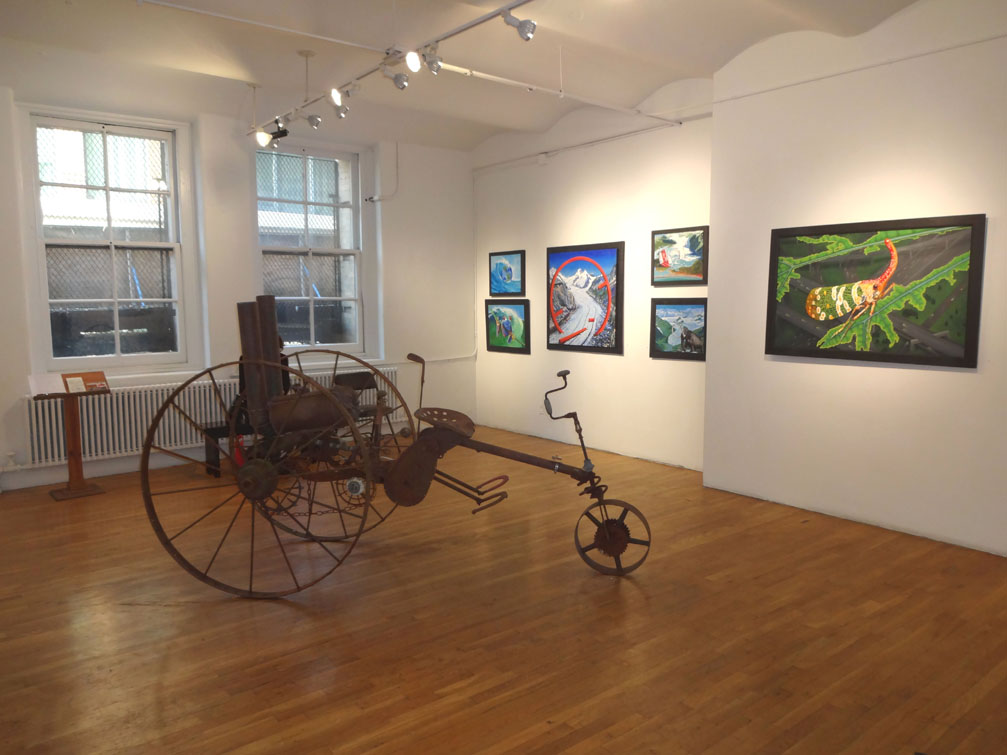
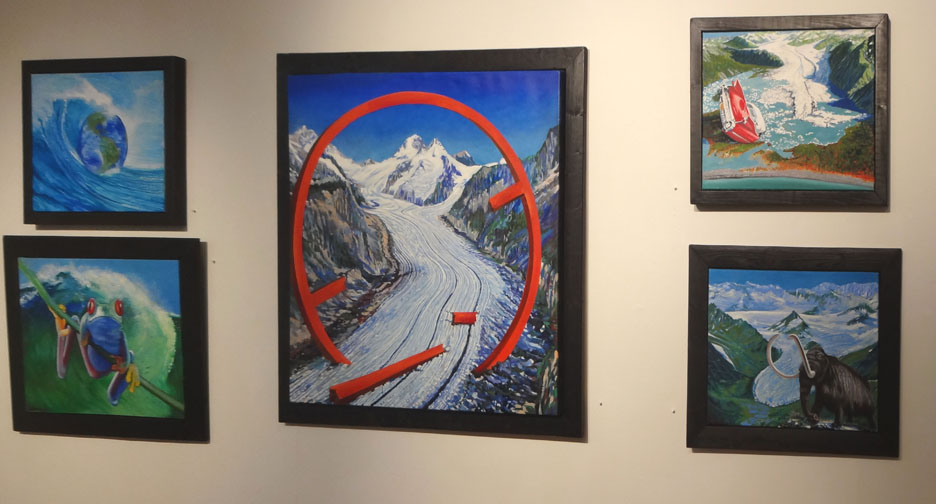
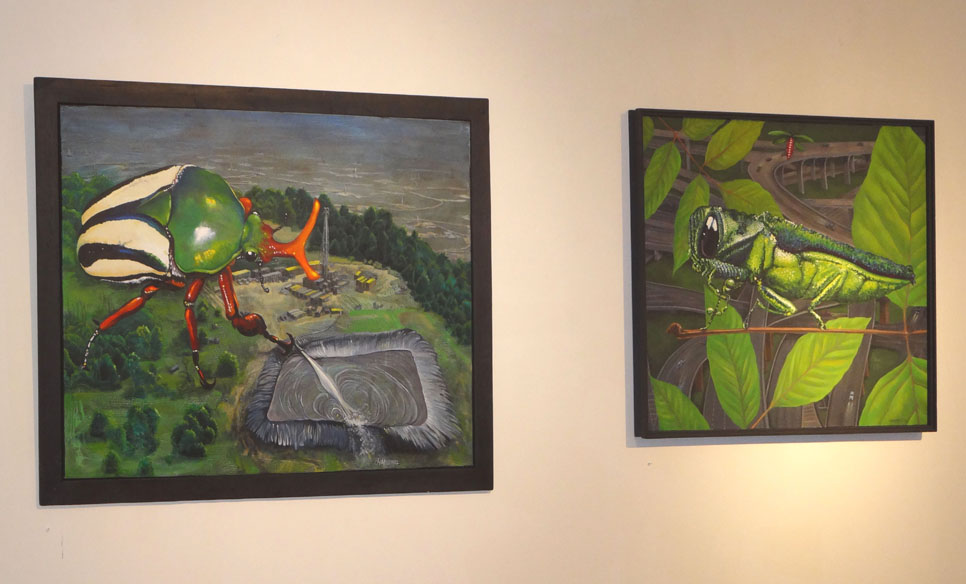
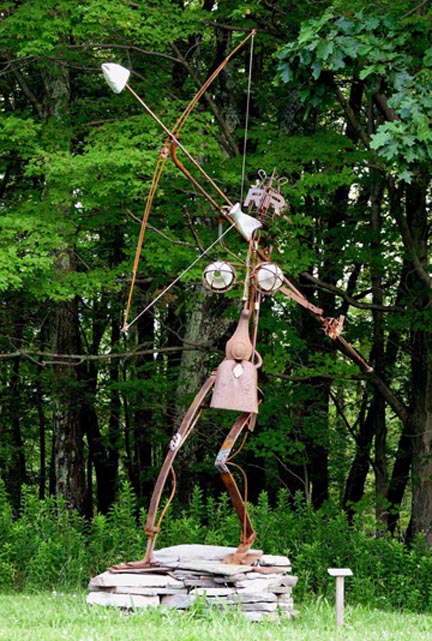
Athena Calico at Gallicurci Estate
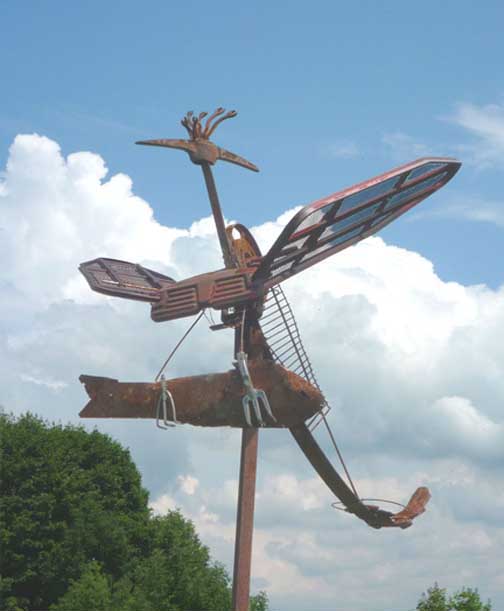
Ironing Bird at Kingston Biennial
CIC Art Park, Outdoor sculpture show, "Skier" and "Hiker" Mt. Tremper NY June 2014-May 2015
NBOS, Outdoor sculpture show, "Thunderhoof" North Bennington Vt July-October 2014
SE14, Outdoor sculpture show, "Headless Horseman" Red Hook NY June-November 2014
Westbeth Gallery, Solo Show, Manhattan NY Feb 1-16 2014
CAS Art Center, River & Biota Show, Livingston Manor NY, Oct-Nov 2014
Limner Gallery, Solo show, Hudson NY - Dec 1 2013 - Jan 5 2014
Kaaterskill Fine Art Gallery, Solo show, Hunter NY 2012
GCAC Gallery Catskill, NY 1011 and 2012
Kingston Biennial, 2009, 2011, 2013
Limner Gallery, Hudson NY 2011
Corinne Miller, Hamptons NY 2010
Gallicurci Estate, Highmount NY 2010
Shandaken Art Studio Tour - Emerson Place - Belleayre Summer Festival 2010
Stone Barns Center for Food & Agriculture, Westchester, Solo show of steel sculptures 2009
Kingston Biennial, Two steel sculptures 2009 Varga Gallery, Woodstock EV/LES show 2008
The Arts Upstairs, Phoenicia NY Frequent exhibitions 2005- 2009
Limner Gallery, Phoenicia NY 2003, 2004 Group shows
Franklin Furnace at Newburgh Sculpture Project, Group show July 29-November 30, 2006
Detroit Museum of New Art 2004 Group show
Gallery Stendhal NY Group shows 1994 – 1998 Museum of the New School 1994 Kinetic sculpture
“No Net Nanette” with Enrico Giordano Biennale di Venezia XENOGRAFIA 1993
“Caution- Artists at Work” video installation Ft. Pierce Art Museum, Ft. Pierce Florida 1992
Solo show of “Space Shuttle” oil paintings Brooklyn Museum 1990 group show including “Polytower” Inflating outdoor sculpture and large oil painting
College of Mount Saint Vincent art gallery 1989 Solo exhibition of oil paintings
Wissner Gallery Brooklyn, NY 1984 solo show of paintings “Global Concern”
Terminal New York exhibition 1983 “Skull and Crossbones” inflating sculpture Reviewed in NYT by Grace Glueck, (read review) All Fool’s Show, Williamsburgh Brooklyn 1982
“Culture Bomb” installation Monumental Show 1981
“Jupiter” inflating sculpture. Review: Jonathan Schell, The Talk of the Town, “Big,” The New Yorker, July 27, 1981
Windows on White- Cryptic Triptych installation 1980 Franklin Furnace NYC 1979, “Earth” inflating silk sculpture
Collections:
Judith Singer
Corinne Miller
Ben & Idith Korman
Gabrielle Stutman
Capella Cole & John Mann - Zen Monestary
Rockefeller Foundation – Stone Barns Center for Food & Agriculture
Pratt Institute school of architecture
Lucy Lasky
Ken and Mona Jacob
Yvonne Sterkin
Nick Arbatsky
Martin Grossman
"THEM!" Paintings and Sculptures by Dave Channon at the Hunter Mountain Foundation Kaaterskill Fine Arts Gallery 8/4 - 11/9 2012
Hunter Village Square, Hunter NY
A word about "THEM!" and Dave Channon:Our world is wildly out of balance. We are invaded by dangerous insects. We are also invaders and destroyers ourselves. This series of oil paintings by Dave Channon clashes and mashes these two concepts in superimposed, surrealistic layers of meaning and perspective. Gorgeous yet devastating Emerald Ash Borers and Asian Longhorn Beetles occupy visual space alongside endangered Costa Rican frogs and bizarre chameleons. The aerial views of knotty highway cloverleaves and fracking waste pools underscore the colossal struggle between man and the natural world.
Channon's steel sculptures reflect the vital energy of creatures and people in a different way. Antique tools and scrap metal are rescued from the dump and recycled into three dimensional collages. These humorous, lopsided mechanical balancing acts make you think Alexander Calder meets Rube Goldberg. Each corroded fragment retains its original identity as it merges into a new whole. A scythe blade becomes the grim reaping spine of a Headless Horseman. A verdigris crusted copper tea kettle is now Popeye's head and sailor cap. Birds, dinosaurs and firemen emerge out of the waste stream of our disposable society.
The paintings make a sincere stab at sophistication, the sculptures display the stupid genius of Basquiat. Which do you prefer? Channon compares his welding sessions to a kid playing with erector sets. There is room for fun and hard work, each have their place. Ideally one can do both at the same time, although he tends to paint in the winter and weld in the summer.
"THEM" refers to a movie where radioactive giant ants colonize the storm drains of Los Angeles. Current flooding issues make us more conscious than ever of infrastructure, environment and our impact on climate change. Channon's paintings and sculptures project the simultaneous tragedy and confusion of the situation. His deep motivation is obvious, but the answer to the riddle is not. As Walt Kelly's Pogo once said. "We have met the enemy and he is us."
Dave Channon has been an active exhibiting painter and sculptor in the New York art scene since his first show in 1979 at Franklin Furnace, an alternative art space in SOHO. He was apprentice to Joseph Cornell in 1969 at the age of seventeen, and has collaborated with such greats as Red Grooms, Phillip Guston and Robert Indiana. His sculptures have been reviewed in the New York Times, the New Yorker, The Village Voice and New York magazine. Channon has exhibited in the New School Museum, The Brooklyn Museum, the Venice Biennale, Stone Barns, a Rockefeller Foundation estate in Westchester, and many well respected galleries. You can see his works at 49A, a sculpture park at the Galli Curci estate in Highmount. Channon is co-founder of the Shandaken Art Studio Tour.
Love Bug 2012

ART: A HUGE EXHIBITION AT BROADWAY TERMINAL
By GRACE GLUECK
Published: September 30, 1983
GOOGLE+
SHARE
SINGLE PAGE
REPRINTS
THE proponents of ''Terminal New York,'' the colossal display of art on view at the former Brooklyn Army Terminal, have billed it as ''potentially the most controversial and innovative exhibition'' since the 1913 Armory Show, but that description doesn't work. The only way it can be related to the earlier exhibition is in its size (it's bigger), and its association with a military space.
It's a different age: the distinctive feature of the Armory Show was its first-time presentation of vanguard European art to an insular American audience; ''Terminal New York'' has nothing very new to offer an audience now up to its ears in the new and the brash. What it conveys in its hodgepodge sprawl is the tremendous energy of today's art scene, deploying the work of some 400 exhibitors in an arena of 125,000 square feet that - with a skylight overhead and a double train track running through it - resembles nothing so much as a movie set for a European railway station. The overwhelming number of objects that vie for attention is enough to glaze the eyes - and blister the feet - of the most avid art adventurer. Like Everest, its phenomenality lies in its scale. The angel behind ''Terminal'' is New York City's Public Development Corporation, which offers city-owned real estate to prospective corporate clients. In 1981, the city acquired the terminal, designed by Cass Gilbert (of Custom House and Woolworth Building fame), built in 1918-19 by the Army and used as a military depot in World War II.
The city is ''redeveloping'' the entire complex - 5 million square feet of space - and hopes to have it fully rented by 1985, to more than 50 companies with jobs for 5,000 New Yorkers. And what better way, the Development Corporation executives figured, to call attention to this architectural extravaganza than by staging a mammoth Manhattan-style art show?
A staff of four - Carol Waag, an artist herself and an employee of the corporation, who hatched the idea for the show; two other artists, Barbara Gary and Rhonda Zwillinger, and Ted Castle, a writer and art critic - did the organizing. The 600 artists who answered the call for proposals were pruned to about 200, and some 200 more - including a number of better- known names - were specially invited to participate. The effort, according to Mr. Castle's introduction to the show's brochure, was to accumulate ''a considerable sample of freshly produced art of almost all kinds,'' which would give viewers ''a revelation not only about art now but also about the state of the world out of which this art arises.''
Well. With something for absolutely everybody, the show has nothing so much as the look of an art department store, with goods ranging from Minimal to Neo-Expressionist and graffiti art, from single objects to complex installations, from vast paintings to tiny toylike pieces, such as a model train placed by Charles Davis, which runs along a railroad track, emitting steam and engine sounds. There are outright political statements and the blandest of abstract forms, photography and video and artists' books. There are shows within the show, such as ''Preparing for War,'' organized by Julius Valiunas and Robert Costa, whose 90-odd participants - among them Vito Acconci, Chris Burden, Richard Mock and the team of Komar and Melamid - deal with the putative military interests of the Reagan regime; and the work of Avant, an artists' group that slaps up its dashed-off paintings all over town. The names run from established to emerging: Alice Aycock, Carl Apfelschmidt, Jean-Michel Basquiat, Mike Bidlo, Martha Diamond, Claudia De Monte, Leon Golub, Nancy Grossman, Richard Hambleton, Mikyng Kim, Les Levine, Dennis Oppenheim, Richard Nicksic, Larry Poons, Carolee Schneeman, Joel Shapiro, Richard Smith, Katie Thamer, Paul Thek, Melissa Wolf, and Kes Zapkus.
But, although the organizers of this multisponsor show get A for effort, it has certain problems, inherent in its dimension and lack of direction. For one, the skylighted central atrium, 740 feet long and eight stories high, bounded on two sides by interior facades from which loading balconies project to sculptural effect, provides such a dazzling experience of space in itself that it tends to overwhelm the art. True, there are some interesting attempts to ''respond'' to this space. One is a menacing outsize inflatable skull and crossbones by David Channon, which hangs from the ceiling; another is a billboard-size painting that spans one set of railroad tracks by Stephen Davis, whose abstract imagery surrounds a photographic inset of the atrium itself, turned dizzily on its side. All kinds of other tricks are played with the ceiling and the ground, ranging from ''The Star System,'' Norman Tuck's contraption of poles, which revolves high up in planetary fashion when a dangling rope is pulled, to Tim Watkins's ''The Train Doesn't Run Here Anymore,'' a planted growth of grass between the tracks.
And then there are the huge and numberless side galleries, in which the displays go on and on and on and on . Faced with this onslaught, all a reviewer can do is mention a few other of the works that caught her attention: Anne Healy's ''Dante's Door,'' a series of three cutout kitelike structures, suspended between columns one behind another, which strikingly liven up dead space; Todd Miner's ''Form Descending,'' which pays hilarious homage to the famous Duchamp work of the Armory show, by its placement of cement plops on rungs in a downward progression around a column; Gerald Nichols's ''Dead Toreador,'' a sculptural takeoff on the Manet painting of that title (in the Metropolitan Museum's Manet show), in which long, faintly figurative wooden slats, spatially lined up to evoke the toreador's recumbent position, are mounted on a wooden frame; a pair of mock bombs by Joseph Chirchirillo, which sprout real grass from shaped armatures packed with earth, and Cliff Petterson's ''nuclear age'' floor shrine, whose fish, serpent and butterfly forms are ingeniously ''painted'' with colored glitter.''Terminal New York,'' at the Harborside Industrial Center, 58th Street and First Avenue in Brooklyn, may be visited Fridays, Saturdays and Sundays through Oct. 30 from noon to 6 P.M. It can be reached by the BMT's N and RR lines to 59th Street in Brooklyn; or by car, on the Brooklyn-Queens Expressway west to the 39th Street exit, driving west on 39th Street and south on First Avenue to the gate. By all means, bring the kiddies. Also of interest this week: William T. Wiley (Allan Frumkin Gallery, 50 West 57th Street): The big news here is that William T. Wiley, the quixotic West Coast painter, draftsman and maker of punny, sometimes poignant mixed-media constructions, has ''gone Lippincott.'' That is, he is producing more formal works of steel and aluminum at the Connecticut foundry of Lippincott, metal fabricators to the art world.
The big question is, how do Mr. Wiley's free-wheeling whimsies, commenting on everything from art and alchemy to nuclear politics, translate into the less permissive medium of fabricated metal? Well, some make it; some don't.
Among those that do is ''Bones, Dunce and Gentleman,'' a comically cosmological work, in which a dunce hat and a top hat each sits on one of the balls of a barbell, which in turn connects two burnished-aluminum pedestals. A small, wistful skeleton, ingeniously fashioned of dark matte steel, dangles from the bar onto the floor. But a big cutout ''Angel'' with a scythe, is arch and folk-artsy; and no, absolutely no, to ''Boo Dada Bar BQ,'' a wood-fronted cutout metal Buddha squatting on a large brazier.
Conclusion: too often the metal confers a monumentality on Mr. Wiley's gifted work that it doesn't really want. But it certainly gives it permanence. There are also a few of the artist's jokey, metaphysical drawings with texts, which are, as usual, appealingly rich in wayward occurrence. (Through Oct. 13.) John Torreano (Hamilton Gallery, 20 West 57th Street): Jewels - flashy, kitschy colored gemstones - are John Torreano's obsession. In earlier exhibitions, he showed ''paintings'' made by affixing swarms of glass baubles to canvas and sculpture contrived by gluing them to shaped pieces of wood. One piece, ''Jewel of Jewels,'' harks back to the old days, a square-cut diamond shape covered with glass bits that lolls atop a high pedestal.
For the rest, he has retreated into more formal representations of jewel stones, producing big, Minimal-looking gem-faceted floor- and wall- pieces coated with aluminum or colored paint rubbed to an elgant finish, and actual paintings in hard, bright whites, yellows, blacks, greens and purples, which make a pass at abstracting the tonal dazzle given off by cut stones. It comes off as refried Pop. (Through next Tuesday.)
